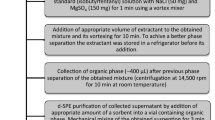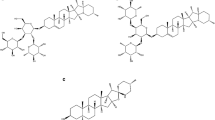Abstract
No published studies reported triazophos (TZP) analysis in human whole blood following fatal intoxication. In this study, a method for the determination of TZP in human whole blood using liquid–liquid extraction (LLE) and thin-layer chromatography (TLC)–ultraviolet (UV) densitometry is described. Chromatography was performed on silica gel 60F254 TLC plates using mobile phase n-hexane:acetone (8:2, v/v) and UV densitometric detection at 248 nm. Better extractions were achieved by using ethyl acetate solvent at pH 5 with a recovery of 92.17%. Calibration curve for TZP in blood was linear from 2 to 100 μg/mL (0.04 to 2 μg/spot) and the sensitivity of the method (LLOQ) was 2 μg/mL (0.04 μg/spot). The method showed excellent within-day precision (0.37 to 0.82%, RSD) and between-day precision (0.39 to 1.47%, RSD) for spiked blood samples at 2, 10, and 50 μg/mL. The measured concentrations of TZP in blood did not deviate more than 2.69% under different storage conditions. TZP concentrations in two fatal cases of poisoning were reported. To the best of our knowledge, this is the first validated TLC–UV densitometric method developed to determine TZP in human whole blood.



Similar content being viewed by others
Abbreviations
- EC:
-
Emulsifiable concentrate
- TLC:
-
Thin-layer chromatography
- LLE:
-
Liquid–liquid extraction
- OPPs:
-
Organophosphorus pesticides
- RSD:
-
Relative standard deviation
- TZP:
-
Triazophos
References
Kapka-Skrzypczak L, Cyranka M, Skrzypczak M, Kruszewski M (2011) Biomonitoring and biomarkers of organophosphate pesticides exposure – state of the art. Ann Agric Environ Med 18(2):294–303
Peter JV, Jerobin J, Nair A, Bennett A (2010) Is there a relationship between the WHO hazard classification of organophosphate pesticide and outcomes in suicidal human poisoning with commercial organophosphate formulations? Regul Toxicol Pharmacol 57:99–102
Park M-J, In S-W, Lee S-K, Choi W-K, Park Y-S, Chung H-S (2009) Postmortem blood concentrations of organophosphorus pesticides. Forensic Sci Int 184:28–31
Martínez MA, Ballesteros S (2012) Two suicidal fatalities due to the ingestion of chlorfenvinphos formulations: simultaneous determination of the pesticide and the petroleum distillates in tissues by gas chromatography-flame-ionization detection and gas chromatography-mass spectrometry. J Anal Toxicol 36:44–51
Tsoukali H, Raikos N, Theodoridis G, Psaroulis D (2004) Headspace solid phase microextraction for the gas chromatographic analysis of methyl-parathion in post-mortem human samples. Application in a suicide case by intravenous injection. Forensic Sci Int 143:127–132
Papoutsis I, Mendonis M, Nikolaou P, Athanaselis S, Pistos C, Maravelias C, Spiliopoulou C (2012) Development and validation of a simple GC-MS method for the simultaneous determination of 11 anticholinesterase pesticides in blood-clinical and forensic toxicology applications. J Forensic Sci 57:806–812
Moriya F, Hashimoto Y, Kuo T-L (1999) Pitfalls when determining tissue distribution of organophosphorus chemicals: sodium fluoride accelerates chemical degradation. J Anal Toxicol 23:210–215
Salm P, Taylor PJ, Roberts D, de Silva J (2009) Liquid chromatography-tandem mass spectrometry method for the simultaneous quantitative determination of the organophosphorus pesticides dimethoate, fenthion, diazinon and chlorpyrifos in human blood. J Chromatogr B 877:568–574
Griffin P, Mason H, Heywood K, Cocker J (1999) Oral and dermal absorption of chlorpyrifos: a human volunteer study. Occup Environ Med 56:10–13
Major uses of pesticides (Registered Under the Insecticides Act (1968) Central Insecticide Board & Registration Committee, Ministry of Agriculture & Farmers Welfare, Government of India. http://www.cibrc.nic.in/mup.htm
Tang M, You M (2012) Isolation, identification and characterization of a novel triazophos-degrading Bacillus sp. (TAP-1). Microbiol Res 167:299–305
Lin K-D, Yuan D-X (2005) Degradation kinetics and products of triazophos in intertidal sediment. J Environ Sci (China) 17(6):933–936
Brzezinka H, Bertram N (2002) Combined thin-layer chromatography and mass spectrometry for the screening of pesticides in samples derived from biological origins. J Chromatogr Sci 40:609–613
Tarbah FA, Mahler H, Temme O, Daldrup T (2001) An analytical method for the rapid screening of organophosphate pesticides in human biological samples and foodstuffs. Forensic Sci Int 121:126–133
Zhao JH, Xiao HB, Yuan HC, Hong Q, Liu MH (2014) Application of three-dimensional fluorescence spectroscopy coupled with ATLD in rapid determination of triazophos content in duck meat. Appl Mech Mater 651-653:362–366
Luzardo OP, Ruiz-Suárez N, Valerón PF, Camacho M, Zumbado M, Henríquez-Hernández LA, Boada LD (2014) Methodology for the identification of 117 pesticides commonly involved in the poisoning of wildlife using GC-MS-MS and LC-MS-MS. J Anal Toxicol 38(3):155–163
Alami R, Jbilou M, Cherrah Y, Laarej K, Yadini AE, Iraqi H, Chraibi A, Faouzi ME (2016) Screening of pesticide residues in blood by GC-MS in patients admitted to the department of endocrinology ibn sina chu rabat. Pharm Lett 8(19):78–85. http://scholarsresearchlibrary.com/archive.html
Chang C, Luo J, Chen M, Wu K, Dong T, He X, Zhou K, Wang L, Chen D, Zhou Z, Wang X, Xia Y (2016) Determination of twenty organophosphorus pesticides in blood serum by gas chromatography-tandem mass spectrometry. Anal Methods 8:4487–4496
Kumari R, Patel DK, Panchal S, Jha RR, Satyanarayana GN, Asati A, Ansari NG, Pathak MK, Kesavachandran C, Murthy RC (2015) Fast agitated directly suspended droplet microextraction technique for the rapid analysis of eighteen organophosphorus pesticides in human blood. J Chromatogr A 1377:27–34
Huen K, Bradman A, Harley K, Yousefi P, Boyd Barr D, Eskenazi B, Holland N (2012) Organophosphate pesticide levels in blood and urine of women and newborns living in an agricultural community. Environ Res 117:8–16
Tsoukali H, Theodoridis G, Raikos N, Grigoratou I (2005) Solid phase microextraction gas chromatographic analysis of organophosphorus pesticides in biological samples. J Chromatogr B 822:194–200
Food and Drug Administration. Guidance for industry, bioanalytical method validation, U.S. Department of Health and Human Services FDA [document online]. Available from URL: www.fda.gov/cder/guidance/10545dft.pdf
Sanganalmath PU, Bharath N, Sreeramulu K (2017) Normal- and reversed-phase thin-layer chromatography of three structurally related organophosphorus pesticides of forensic importance. J Plan Chromatogr 30(3):154–163
Calverley R, Williams L, Merriman S, Lodder H, Howells A, Jordan S, Desbrow C, Cleeve M (2006) High throughput extraction of drugs from biological fluids using an improved supported liquid extraction plate, in: Karlovšek, M. Z., (Ed.), Book of TIAFT 2006 Abstracts. Published by Medical Faculty of University of Ljubljana pp. 247-249 (ISBN 961-6264-81-8)
García-Repetto R (2018) Sample preparation for pesticide analysis in a forensic toxicology laboratory: a review. J Forensic Sci Digit Investig 1:27–45
Raikos N, Spagou K, Vlachou M, Pouliopoulos A, Thessalonikeos E, Tsoukali H (2009) Development of a liquid-liquid extraction procedure for the analysis of amphetamine in biological specimens by GC-FID. Open Forensic Sci J 2:12–15
Karlonas N, Padarauskas A, Ramanavičius A, Minkuvienė Z, Ramanavičienė A (2012) Rapid and highly sensitive determination of clonazepam and 7-aminoclonazepam in whole blood using gas chromatography with negative-ion chemical ionization mass spectrometry. Chemija 23:91–99
Menezes Filho A, dos Santos FN, Pereira PAP (2010) Development, validation and application of a method based on DI-SPME and GC–MS for determination of pesticides of different chemical groups in surface and groundwater samples. Microchem J 96:139–145
Tarbah FA, Kardel B, Pier S, Temme O, Daldrup T (2004) Acute poisoning with phosphamidon: determination of dimethyl phosphate (DMP) as a stable metabolite in a case of organophosphate insecticide intoxication. J Anal Toxicol 28:198–203
Thompson TS, Treble RG, Magliocco A, Roettger JR, Eichhorst JC (1998) Case study: fatal poisoning by malathion. Forensic Sci Int 95:89–98
Richardson T (2000) Pitfalls in forensic toxicology. Ann Clin Biochem 37:20–44
Akgür SA, Öztürk P, Yemişcigil A, Ege B (2003) Rapid communication: postmortem distribution of organophosphate insecticides in human autopsy tissues following suicide. J Toxicol Environ Health A 66:2187–2191
Akcan R, Hilal A, Daglioglu N, Cekin N, Gulmen MK (2009) Determination of pesticides in postmortem blood and bone marrow of pesticide treated rabbits. Forensic Sci Int 189:82–87
Acknowledgments
The authors are thankful to the Director, Directorate of Forensic Science Laboratories, Bengaluru, and Deputy Director, Regional Forensic Science Laboratory, Kalaburagi, Karnataka, India, for their support.
Author information
Authors and Affiliations
Corresponding author
Ethics declarations
Conflict of interest
The authors declare that they have no conflict of interest.
Ethical statement
This article does not contain any studies with human participants or animals.
Additional information
Publisher's note
Springer Nature remains neutral with regard to jurisdictional claims in published maps and institutional affiliations.
Rights and permissions
About this article
Cite this article
Sanganalmath, P.U., Nagaraju, P.M. & Sreeramulu, K. Development and validation of a simple and rapid thin-layer chromatography–UV densitometry method for the determination of triazophos in human whole blood for forensic toxicological applications. JPC-J Planar Chromat 33, 255–262 (2020). https://doi.org/10.1007/s00764-020-00022-3
Received:
Accepted:
Published:
Issue Date:
DOI: https://doi.org/10.1007/s00764-020-00022-3




